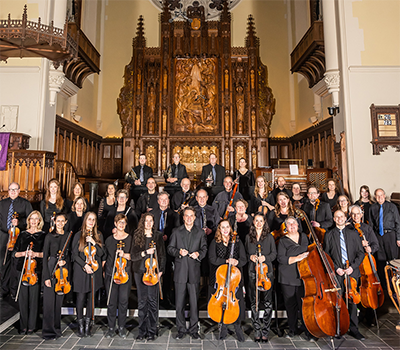by Daniel Hathaway

Blue Water comprises musicians and features soloists who live in Northeast Ohio, asks its audiences to “Pay what you wish,” and has committed itself to straight-through programs that normally run less than 90 minutes.
Grammy-winner Jason Vieaux, the featured soloist in a collaboration between BlueWater and the Cleveland Classical Guitar Society, is both an international touring artist and a local hero, who treated the capacity audience to an elegant performance of Vivaldi’s D-major concerto — originally for lute — with a fine sense of pacing and crisp articulations. Vieaux played out in solo passages and blended with the string orchestra when the composer intended for the plucked instrument to be part of the ensemble.
Both soloist and ensemble contributed stylish playing in the slow movement, giving a sense of direction to the melodic lines. The third movement was a pure Vivaldian romp, but effortlessly played by all.
Meyer conducted an impromptu interview with Vieaux before launching into the Cleveland premiere of Avner Dorman’s engaging How to Love, a meditation on mindfulness by a Vietnamese Buddhist monk, each of its four movements bearing the title of a chapter in his eponymous book.
‘I Am Here For You’ begins with an arpeggiated chord over a long note in the strings, leading to a dialogue between soloist and orchestra featuring catchy, syncopated rhythms that alternate with slow, serene sections.
The fun, recurring theme in ‘I Know You Are There And I Am Happy’ represents its mindful moment with jazzy, accented pizzicati over a walking bass.
‘This Is A Happy Moment’ finds the solo guitar giving a lyrical speech over orchestral pizzicati, and the finale, ‘You Are Partly Right,’ puts its message across in long solo lines over a nearly perpetual motion ostinato decorated with snap pizzicatos.
Vieaux presented Dorman’s technically challenging piece with apparent ease and a clear sense of its meaning and direction. Dorman’s inventive music is appealing to a variety of audiences, and Saturday’s crowd responded to the piece and its performers with a long, strong ovation. In return, Vieaux gave the crowd the prelude from J.S. Bach’s first solo cello suite.Swe
Having waited patiently in the wings, Blue Water’s fine wind section joined their string playing colleagues for a spirited performance of Beethoven’s Seventh Symphony, cannily paced by Meyer, who kept things constantly moving forward.
Lovely playing from Sean Gabriel, flute, Martin Neubert, oboe, and Phillip Austin, bassoon, contrasted with the persistent rhythmic motif laid down by the strings in the second movement, and the winds pounced on their big moment to shine in the trio of the third.
Meyer hammered home the repetitive earworm that suffuses the finale each time it came around, and generally called for angular, accented playing from his colleagues. If the horns — who had multiple high, exposed notes to play — overpowered the orchestra at times, that might actually have made the composer happy.
In a nice outdoor contrast to the orchestral doings inside, the McGaffin Carillon serenaded University Circle before the performance from its tower attached to the church. Carillonneur Kieran Cantilina’s playlist was printed, Dutch-style, in the concert program.
Published on ClevelandClassical.com May 9, 2024.
Click here for a printable copy of this article



